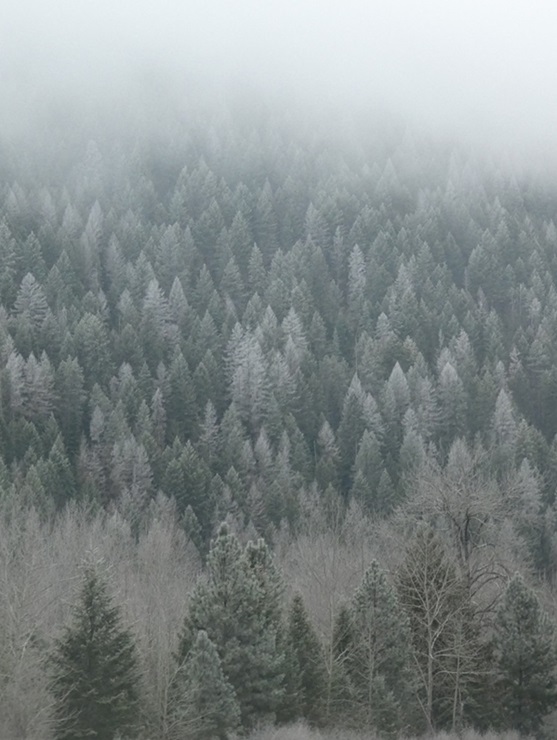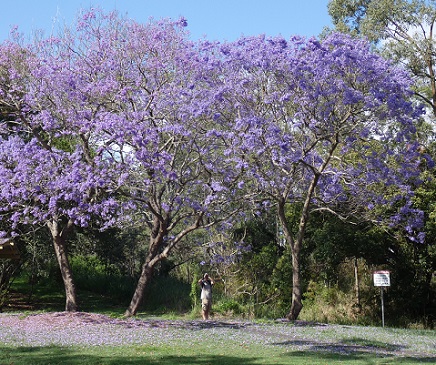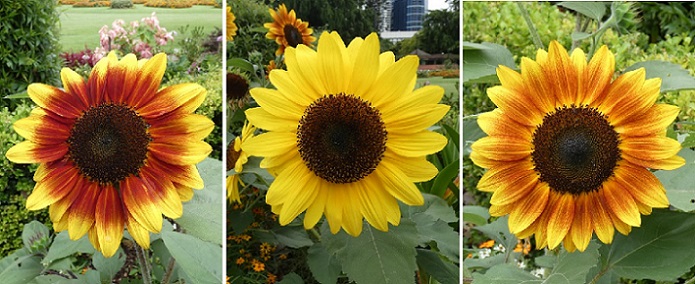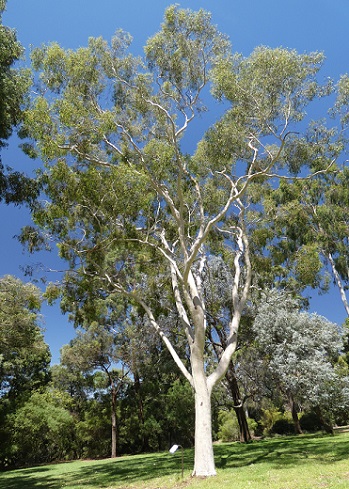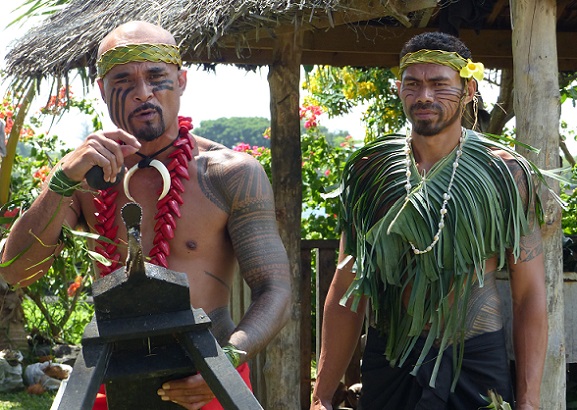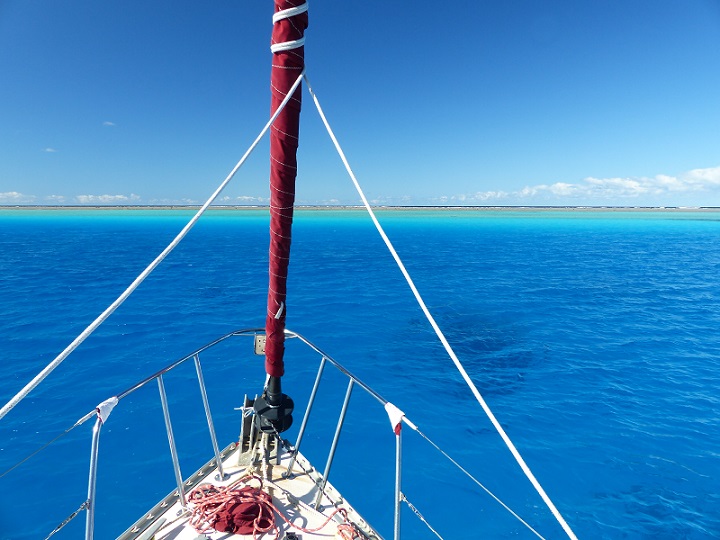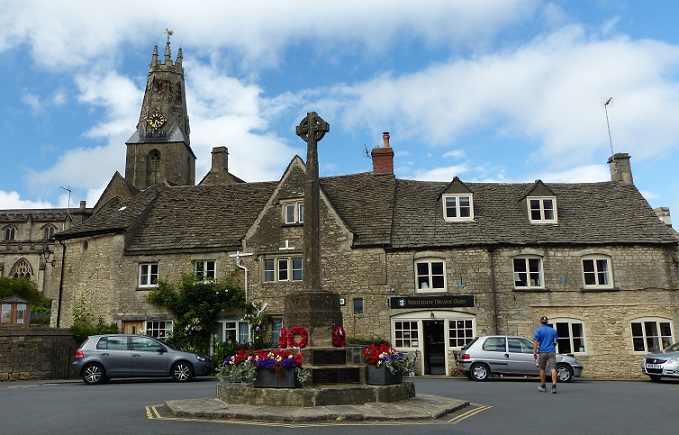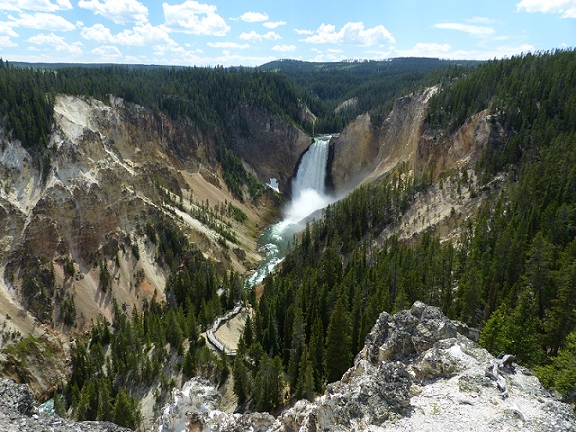
Tregoning
12 April 2024 | We are back aboard Tregoning in Mersin Marina, Mersin, Türkiye
02 April 2024 | We are in Toronto Airport, Canada: Tregoning is in Mersin Marina, Mersin, Türkiye
25 February 2024 | We are back in Gainesville, FL: Tregoning is in Mersin Marina, Mersin, Türkiye
18 February 2024 | We are in Glenwood, New Mexico: Tregoning is in Mersin Marina, Mersin, Türkiye
12 February 2024 | We are in Morro Bay, California: Tregoning is in Mersin Marina, Mersin, Türkiye
19 January 2024 | We are in Vancouver, BC Canada: Tregoning is in Mersin Marina, Mersin, Türkiye
01 January 2024 | We are in Washington State: Tregoning is in Mersin Marina, Mersin, Türkiye
15 December 2023 | We are in Minnesota: Tregoning is in Mersin Marina, Mersin, Türkiye
18 November 2023 | We are in Florida: Tregoning is in Mersin Marina, Mersin, Türkiye
29 October 2023 | We're in Florida - Tregoning is at B-dock, Mersin Marina, Mersin, Türkiye
21 October 2023 | 7 Oda Kapadokya Cave Hotel, Ürgüp, Türkiye
14 October 2023 | Hotel Aşikoğlu, Boğazkale, Türkiye
07 October 2023 | B-dock, Mersin Marina, Mersin, Türkiye
19 September 2023 | “Chez Jon & Angela”, Near Otterton, Devon, UK
14 September 2023 | Airbnb in Fortuneswell on the Isle of Portland, Dorset, UK
11 September 2023 | With Mike, Grange-over-Sands, Cumbria, UK
03 September 2023 | Ardington House, Ardington, Oxfordshire, UK
24 August 2023 | Near "Chez Joan and Peter", College of Roseisle, Moray, Scotland
11 August 2023 | Andrew's house (not exactly), Lichfield, UK
22 July 2023 | Chez Gail, near the New York Café, Budapest, Hungary
Reporting from the reef
19 July 2017 | Anchorage off Big Mama’s Yacht Club, Pangaimotu, near Tongatapu, Tonga
Photo: A striped surgeonfish (38 cm or 15 inches) in a shallow part of the reef around Pangiamotu, Tonga
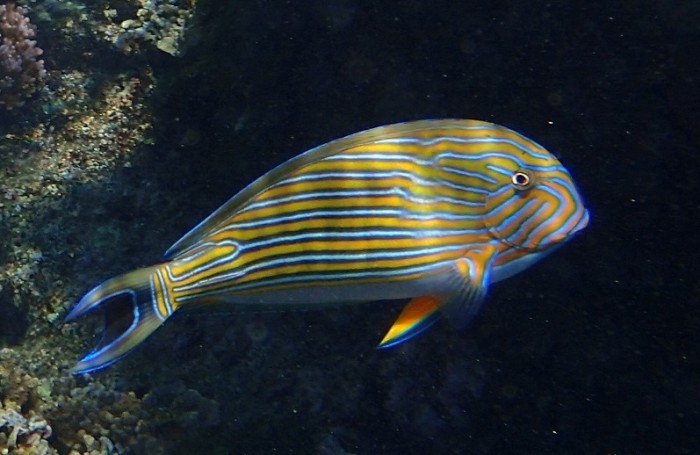
Those who know my love of snorkeling and obsession with finding reef fish that we have not seen before, may be wondering why we have stayed so long in Tongatapu and snorkeled so infrequently. To answer the second question first, we were spoiled by the snorkeling conditions at Minerva in the clear open-ocean water and by comparison the water around Pangaimotu and even Fafa has seemed rather cloudy most of the time. Conditions should improve again as we get away from the population density of Tongatapu although some of the stirred-up water has also been the result of many days of brisk winds. These winds also make riding wet in the dinghy and showering on the deck afterwards a little less appealing, especially since the water at 75°F (24°C) starts to feel rather cold after a long snorkel...a condition that might not be entirely unrelated to the severity of Randall's cold.
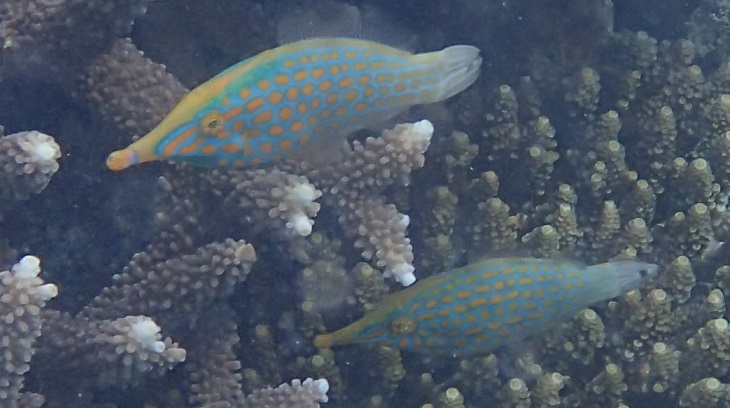
A pair of longnose filefish (8 cm or 3 inches long)
Part of reason why we have not yet moved north to the Otu Tolu, Lulunga, and Ha'apai Groups of Tonga is because of the unsettled weather that has given us long spells (5-7 consecutive days) of winds of at least 15 knots, with stronger winds forecast to our north. Having not spent this time of year in this area before, we do not know whether or not these unsettled conditions are typical for a south-Tongan winter. Our impression from the Gulf Harbour Radio weather team is that this is a particularly turbulent year for air-pressure troughs and ridges in the Tasman Sea (between Australia and New Zealand) which affect the weather throughout the western part of the South Pacific Ocean. David counted 13 troughs and ridges on his weather map this morning which was the highest he has seen in a while. We hope that the influence of this will diminish and we will see better weather as we head further north through Tonga to Samoa and as springtime approaches, but reports from the Vava'u Group are currently not much better then here.
We had planned to leave for the Ha'apai Islands last week and had even got our Inter-Island clearance papers from Customs Officer Duke (it was a full-day process to track him down). We got as far as Fafa Island but the winds were stronger than we had hoped and, the day after he snorkeled and stayed-up late for the Polynesian Feast, we found that Randall was not over his cold and so we returned to the relative shelter of Pangaimotu.
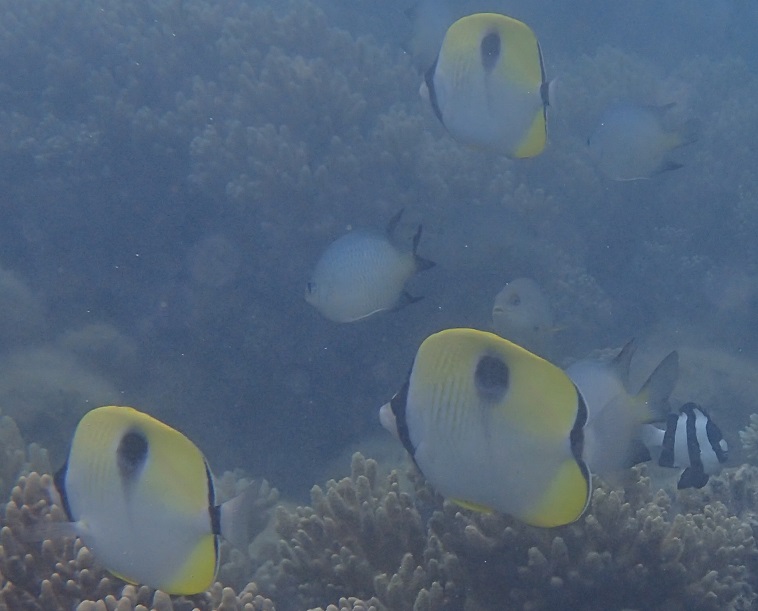
Teardrop butterflyfish (20 cm or 8 inches), a humbug dascyllus (right) and mystery fish (maybe scaly damsel) in the milky water at Pangaimotu
While southerly or southeasterly winds would be good for sailing north, we want to stop at one of the northern Tongatapu Islands, Malinoa, which Phil on SV Silhouette had recommended and which does not have much protection from wind waves. We are also interested in trying to stop at one of the southern Otu Tolu Islands, Kelefesia, because Dean on SV Local Talent had said that it was one of his favorite islands anywhere in the world (a pretty impressive recommendation). Kelefesia does not have much protection from swells so is best visited when it is fairly calm. Having only a small lagoon, there is only room for 3 or 4 boats. So, while at a distance of 48 nm Kelefesia is just a long day-sail away, both it and Malinoa are places best visited when winds are subdued and motoring would be required. Also, if the anchorage at Kelefesia was full, it would be better to be able to make a slow overnight continuation, in calm conditions, to another anchorage further north such as Nomuka. Typical sailors, we nearly always seem to want more or less wind than we have.
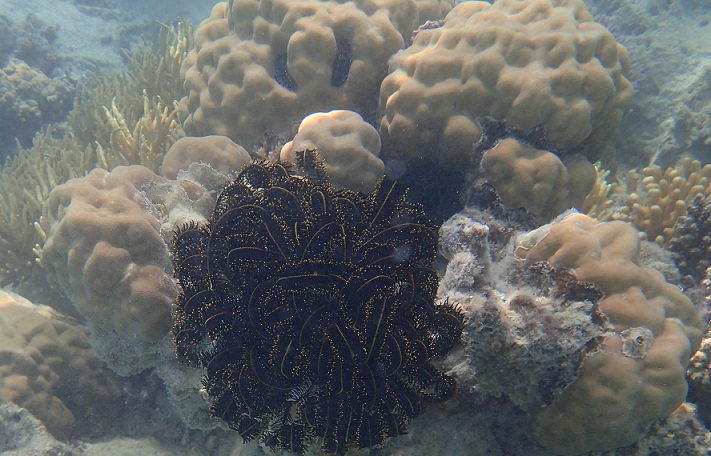
A black and yellow crinoid in the Pangaimotu lagoon (crinoids are in the phylum Echinodermata along with starfish, sea urchins, sand dollars, and sea cucumbers)
Still, between us we have enjoyed a few snorkels in the marine reserves around Pangaimotu and Fafa. Inside the sandy bottomed, shallow lagoon (up to 3 m or 10 feet deep) on the northwest side of Pangaimotu, there are more soft-corals than I remember ever having seen in one place before. These look like hard corals until water movement makes their branches jiggle or, when exposed at low tide, they temporarily collapse and look like a bunch of rubber-gloves that have been half-filled with jelly.
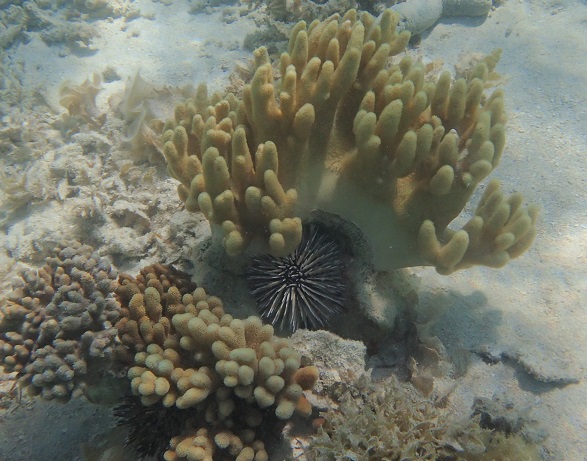
Soft corals and a sea urchin in Pangaimotu lagoon
There are plenty of small fish in this habitat which is the perfect place to drift over towing the dinghy. I am still working on remembering the names of fish that are familiar but, on the whole, Randall and I are both pretty good at noticing fish that we have not seen before...or at least we think we are. Taking photographs has helped but the breezes stirring up the shallow water reduce the water's clarity so the pictures have tended to be rather milky. The diversity of butterflyfish, damselfish, and wrasse in the lagoon is particularly captivating. Species new to me in this area included: one-spot demoiselle, bluntsnout Gregory, yellow barracuda, Batu coris, New Guinea wrasse, blackeye thicklips, crescent wrasse, sharpnose sandperch, jeweled blenny, white-eyed moray, and, possibly, scaly and Philippines damsels.
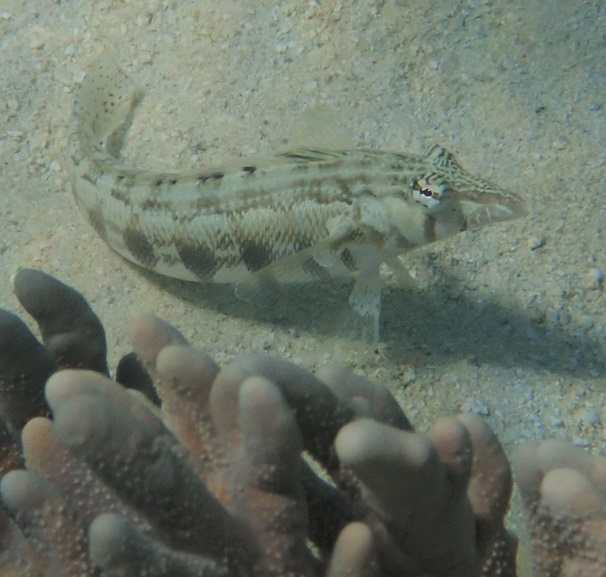
Sharpnose sandperch (18 cm or 7 inches) with a rubber-glove-like soft coral in the foreground
Going over the edge of the hard-coral reef on the north side of the lagoon (stretches of which are exposed at low tides), reveals a drop-off to about 10 m (33 feet). Again, water clarity has not be great here but the hard corals are diverse and there are quite a few larger fish including, new to me, chameleon parrotfish and a 60-cm (2-feet) long many-spotted sweetlips. Drifting along this wall towing the dinghy is a very relaxing way to snorkel and can include viewing shallow, surge-loving fish at the top (e.g., the striped surgeonfish) and larger, deeper-water fish (e.g., the sweetlips) lower down.
My three snorkels at Fafa were all on the outside of the fringing reef. Rather than forming a vertical wall, the hard corals form impressive slopes that look as though tall piles of corals were just dumped and are slowly spilling down to the sandy seafloor. According to Tom from the resort, most of the hard corals at Fafa Island are showing just five years' of regrowth since the marine reserve was created. Before that they were badly damaged by storms and by thoughtless collectors of sea cucumbers for export to markets in China. There are many large plate-like corals and regrowth of staghorn corals is particularly spectacular. Both large and small fish proliferate in this habitat including a diversity of parrotfish. Fish new to me included the eastern triangular butterflyfish and tubelip wrasse.

Plate and staghorn hard corals at Fafa Island
Incidentally, the narrow channel through the reef on the north side of Fafa Island is not a straight line and while there is a pole with reflective tape to show the outside entrance, we had been a bit nervous about trying this in the dark on our way back from the Polynesian dinner. So during the afternoon when we had good light to see the shallow coral, we entered the channel in the dinghy using the hand-held GPS to plot a route. Having tested that we could follow this route back out with me only looking at the GPS and giving instructions to Randall at the helm, we were then pretty confident that we could get back to Tregoning in the dark without hitting the reef. To be on the safe side, Randall rowed on that trip rather than using the outboard and it worked well.
In the bright beam from my flashlight, we could see thousands of small somethings leaping in small arcs (maybe 10 cm or 4 inches in diameter) at random across the surface of the calm water. I assumed that these were tiny fish or shrimp, or large plankton but when I caught some, they appeared to have wings and look more like flying ants. Marine insects? A quick online search did not identify anything similar. Our entomologist friend Jim had once told us that flies we found far offshore may be completing their life-cycle on bits of floating debris but the jumpers in the water at Fafa seemed to be insects coming from, and returning to, just below the surface of relatively clean seawater. Hmmmm...of course, I had enjoyed a couple of cocktails earlier in the evening and did not have my reading glasses on...
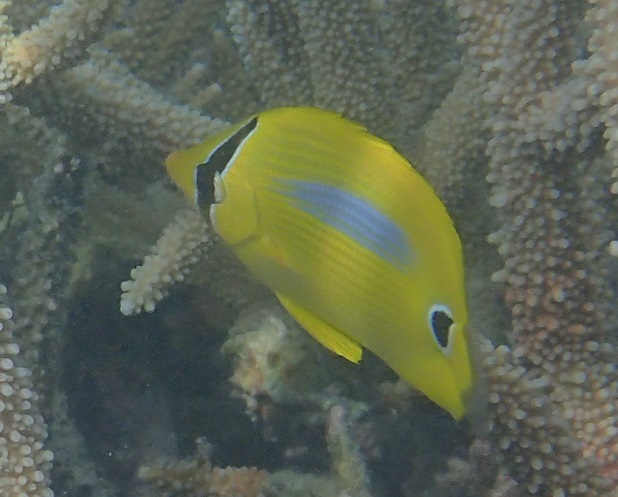
A young blue-spot butterfly fish (10 cm or 4 inches)
Comparing snorkeling observations with Marisa on SV Devocean and Deb (with Gregg) on SV Kalliope has been very interesting, especially as they each have different fish identification books. Deb is a particularly skilled photographer so while I have felt good about being able to help name several of her "mystery fish", the quality of her pictures gives me plenty of incentive to try to improve our shots.
Marisa's book "Reef Fish of the World: Indo-Pacific and Caribbean" by Lieske and Myers is definitely one that we will add to our collection when we get a chance to order it. Using drawings rather than photographs, it will be a useful complement to our book "Reef Fish Identification: Tropical Pacific" by Allen, Steene, Humann, and Deloach.

A rather blurry picture of our black and white striped mystery fish from Minerva Reef
Using Marisa's book, I finally found a genus for the black-and-white striped mystery fish that we had seen at Minerva Reef. I was then able to search for morwongs online and discovered that it was a blacktip morwong (Cheilodactylus francisi). This species was first formally identified in 2004 with a distribution from eastern Australia to New Caledonia and the Kermadec Island (northeast of New Zealand) so its presence in Minerva Reef is quite plausible. This mystery had been really bugging me because I knew that I had seen a picture of a similar morwong before but without being able to recall this name or to find that picture, I had been previously stumped on my internet searches.
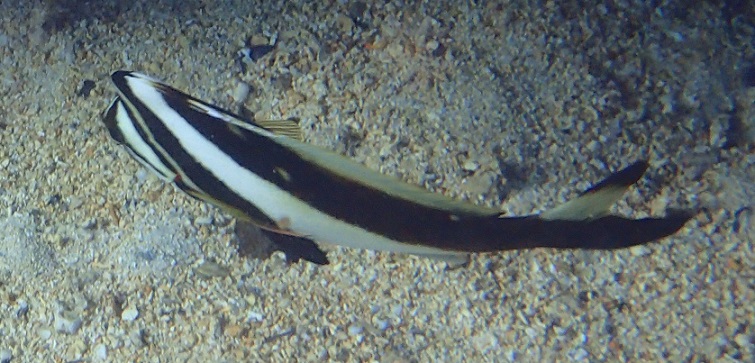
A top view of the blacktip morwong (blacktip on upper tail lobe) at Minerva Reef (about 30 cm or 12 inches)
I have only seen one shark around Tongatapu, and that was a black-tipped reef shark that made a quick U-turn and swam away when it saw us in the water at Fafa Island. Another creature in this area that has the potential to be a bit alarming is the black and white striped sea snake, the banded sea krait (Laticauda colubrina). Sea snakes in general have more deadly venom than many land-swelling speices which, understandably, gives them a bad reputation. However, this particular sea snake is not aggressive, and with fangs at the back of its mouth it really has to chew on you to get any venom into you. Most bites occur when people try to remove them from their fishing nets.
The banded sea krait feeds in the sea and has a paddle-shaped tail to facilitate its swimming, but adults return to land to digest, sleep, and reproduce and this shoreline pattern of behavior often brings it into contact with people. Apparently, there are some around the wrecks by Big Mama's Yacht Club and inshore of our anchorage but I have not snorkeled on those yet. I did find a banded sea krait, however, when I was standing in the dinghy and saw it swimming at the water's surface, next to Tregoning's hull. When I got the dinghy too close for a better look, it swam downwards so, unfortunately, Randall did not have a chance to see it. I hope that their penchant for wrecks in the area is not an inauspicious omen for finding one checking-out Tregoning!

A pair of longnose filefish (8 cm or 3 inches long)
Part of reason why we have not yet moved north to the Otu Tolu, Lulunga, and Ha'apai Groups of Tonga is because of the unsettled weather that has given us long spells (5-7 consecutive days) of winds of at least 15 knots, with stronger winds forecast to our north. Having not spent this time of year in this area before, we do not know whether or not these unsettled conditions are typical for a south-Tongan winter. Our impression from the Gulf Harbour Radio weather team is that this is a particularly turbulent year for air-pressure troughs and ridges in the Tasman Sea (between Australia and New Zealand) which affect the weather throughout the western part of the South Pacific Ocean. David counted 13 troughs and ridges on his weather map this morning which was the highest he has seen in a while. We hope that the influence of this will diminish and we will see better weather as we head further north through Tonga to Samoa and as springtime approaches, but reports from the Vava'u Group are currently not much better then here.
We had planned to leave for the Ha'apai Islands last week and had even got our Inter-Island clearance papers from Customs Officer Duke (it was a full-day process to track him down). We got as far as Fafa Island but the winds were stronger than we had hoped and, the day after he snorkeled and stayed-up late for the Polynesian Feast, we found that Randall was not over his cold and so we returned to the relative shelter of Pangaimotu.

Teardrop butterflyfish (20 cm or 8 inches), a humbug dascyllus (right) and mystery fish (maybe scaly damsel) in the milky water at Pangaimotu
While southerly or southeasterly winds would be good for sailing north, we want to stop at one of the northern Tongatapu Islands, Malinoa, which Phil on SV Silhouette had recommended and which does not have much protection from wind waves. We are also interested in trying to stop at one of the southern Otu Tolu Islands, Kelefesia, because Dean on SV Local Talent had said that it was one of his favorite islands anywhere in the world (a pretty impressive recommendation). Kelefesia does not have much protection from swells so is best visited when it is fairly calm. Having only a small lagoon, there is only room for 3 or 4 boats. So, while at a distance of 48 nm Kelefesia is just a long day-sail away, both it and Malinoa are places best visited when winds are subdued and motoring would be required. Also, if the anchorage at Kelefesia was full, it would be better to be able to make a slow overnight continuation, in calm conditions, to another anchorage further north such as Nomuka. Typical sailors, we nearly always seem to want more or less wind than we have.

A black and yellow crinoid in the Pangaimotu lagoon (crinoids are in the phylum Echinodermata along with starfish, sea urchins, sand dollars, and sea cucumbers)
Still, between us we have enjoyed a few snorkels in the marine reserves around Pangaimotu and Fafa. Inside the sandy bottomed, shallow lagoon (up to 3 m or 10 feet deep) on the northwest side of Pangaimotu, there are more soft-corals than I remember ever having seen in one place before. These look like hard corals until water movement makes their branches jiggle or, when exposed at low tide, they temporarily collapse and look like a bunch of rubber-gloves that have been half-filled with jelly.

Soft corals and a sea urchin in Pangaimotu lagoon
There are plenty of small fish in this habitat which is the perfect place to drift over towing the dinghy. I am still working on remembering the names of fish that are familiar but, on the whole, Randall and I are both pretty good at noticing fish that we have not seen before...or at least we think we are. Taking photographs has helped but the breezes stirring up the shallow water reduce the water's clarity so the pictures have tended to be rather milky. The diversity of butterflyfish, damselfish, and wrasse in the lagoon is particularly captivating. Species new to me in this area included: one-spot demoiselle, bluntsnout Gregory, yellow barracuda, Batu coris, New Guinea wrasse, blackeye thicklips, crescent wrasse, sharpnose sandperch, jeweled blenny, white-eyed moray, and, possibly, scaly and Philippines damsels.

Sharpnose sandperch (18 cm or 7 inches) with a rubber-glove-like soft coral in the foreground
Going over the edge of the hard-coral reef on the north side of the lagoon (stretches of which are exposed at low tides), reveals a drop-off to about 10 m (33 feet). Again, water clarity has not be great here but the hard corals are diverse and there are quite a few larger fish including, new to me, chameleon parrotfish and a 60-cm (2-feet) long many-spotted sweetlips. Drifting along this wall towing the dinghy is a very relaxing way to snorkel and can include viewing shallow, surge-loving fish at the top (e.g., the striped surgeonfish) and larger, deeper-water fish (e.g., the sweetlips) lower down.
My three snorkels at Fafa were all on the outside of the fringing reef. Rather than forming a vertical wall, the hard corals form impressive slopes that look as though tall piles of corals were just dumped and are slowly spilling down to the sandy seafloor. According to Tom from the resort, most of the hard corals at Fafa Island are showing just five years' of regrowth since the marine reserve was created. Before that they were badly damaged by storms and by thoughtless collectors of sea cucumbers for export to markets in China. There are many large plate-like corals and regrowth of staghorn corals is particularly spectacular. Both large and small fish proliferate in this habitat including a diversity of parrotfish. Fish new to me included the eastern triangular butterflyfish and tubelip wrasse.

Plate and staghorn hard corals at Fafa Island
Incidentally, the narrow channel through the reef on the north side of Fafa Island is not a straight line and while there is a pole with reflective tape to show the outside entrance, we had been a bit nervous about trying this in the dark on our way back from the Polynesian dinner. So during the afternoon when we had good light to see the shallow coral, we entered the channel in the dinghy using the hand-held GPS to plot a route. Having tested that we could follow this route back out with me only looking at the GPS and giving instructions to Randall at the helm, we were then pretty confident that we could get back to Tregoning in the dark without hitting the reef. To be on the safe side, Randall rowed on that trip rather than using the outboard and it worked well.
In the bright beam from my flashlight, we could see thousands of small somethings leaping in small arcs (maybe 10 cm or 4 inches in diameter) at random across the surface of the calm water. I assumed that these were tiny fish or shrimp, or large plankton but when I caught some, they appeared to have wings and look more like flying ants. Marine insects? A quick online search did not identify anything similar. Our entomologist friend Jim had once told us that flies we found far offshore may be completing their life-cycle on bits of floating debris but the jumpers in the water at Fafa seemed to be insects coming from, and returning to, just below the surface of relatively clean seawater. Hmmmm...of course, I had enjoyed a couple of cocktails earlier in the evening and did not have my reading glasses on...

A young blue-spot butterfly fish (10 cm or 4 inches)
Comparing snorkeling observations with Marisa on SV Devocean and Deb (with Gregg) on SV Kalliope has been very interesting, especially as they each have different fish identification books. Deb is a particularly skilled photographer so while I have felt good about being able to help name several of her "mystery fish", the quality of her pictures gives me plenty of incentive to try to improve our shots.
Marisa's book "Reef Fish of the World: Indo-Pacific and Caribbean" by Lieske and Myers is definitely one that we will add to our collection when we get a chance to order it. Using drawings rather than photographs, it will be a useful complement to our book "Reef Fish Identification: Tropical Pacific" by Allen, Steene, Humann, and Deloach.

A rather blurry picture of our black and white striped mystery fish from Minerva Reef
Using Marisa's book, I finally found a genus for the black-and-white striped mystery fish that we had seen at Minerva Reef. I was then able to search for morwongs online and discovered that it was a blacktip morwong (Cheilodactylus francisi). This species was first formally identified in 2004 with a distribution from eastern Australia to New Caledonia and the Kermadec Island (northeast of New Zealand) so its presence in Minerva Reef is quite plausible. This mystery had been really bugging me because I knew that I had seen a picture of a similar morwong before but without being able to recall this name or to find that picture, I had been previously stumped on my internet searches.

A top view of the blacktip morwong (blacktip on upper tail lobe) at Minerva Reef (about 30 cm or 12 inches)
I have only seen one shark around Tongatapu, and that was a black-tipped reef shark that made a quick U-turn and swam away when it saw us in the water at Fafa Island. Another creature in this area that has the potential to be a bit alarming is the black and white striped sea snake, the banded sea krait (Laticauda colubrina). Sea snakes in general have more deadly venom than many land-swelling speices which, understandably, gives them a bad reputation. However, this particular sea snake is not aggressive, and with fangs at the back of its mouth it really has to chew on you to get any venom into you. Most bites occur when people try to remove them from their fishing nets.
The banded sea krait feeds in the sea and has a paddle-shaped tail to facilitate its swimming, but adults return to land to digest, sleep, and reproduce and this shoreline pattern of behavior often brings it into contact with people. Apparently, there are some around the wrecks by Big Mama's Yacht Club and inshore of our anchorage but I have not snorkeled on those yet. I did find a banded sea krait, however, when I was standing in the dinghy and saw it swimming at the water's surface, next to Tregoning's hull. When I got the dinghy too close for a better look, it swam downwards so, unfortunately, Randall did not have a chance to see it. I hope that their penchant for wrecks in the area is not an inauspicious omen for finding one checking-out Tregoning!
Comments
| Vessel Name: | Tregoning |
| Vessel Make/Model: | Morgan Classic 41 |
| Hailing Port: | Gainesville, FL |
| Crew: | Alison and Randall |
| About: | We cast-off from Fernandina Beach in north Florida on 1st June 2008 and we have been cruising on Tregoning ever since. Before buying Tregoning, both of us had been sailing on smaller boats for many years and had worked around boats and water throughout our careers. |
| Extra: | “Tregoning” (rhymes with “belonging”) and is a Cornish word (meaning “homestead of Cohnan” or “farm by the ash trees”) and was Alison's mother’s middle name. Cornwall is in southwest England and is where Alison grew-up. |
Tregoning's Photos - Main
 |
Extra photographs from our three-week campervan tour of the South Island from November 15th to December 5th 2015
217 Photos
Created 4 January 2016
|
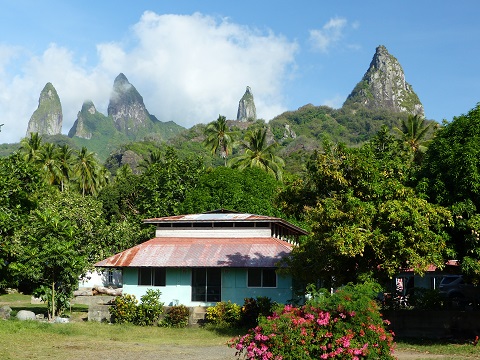 |
Random pictures from our month spent on the islands of Hiva Oa, Tahuata, Ua Pou, and Nuku Hiva
45 Photos
Created 18 July 2015
|
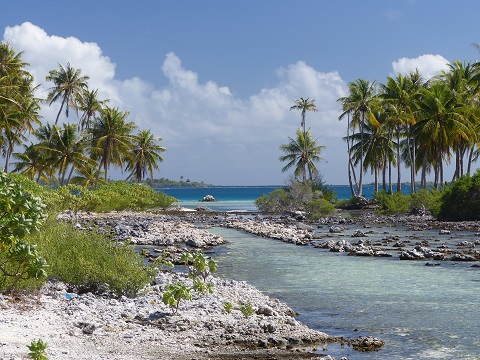 |
Random pictures from our month spent in 4 Tuamotu Atolls; Ahe, Fakarava, Tahanea, and Toau
32 Photos
Created 1 July 2015
|
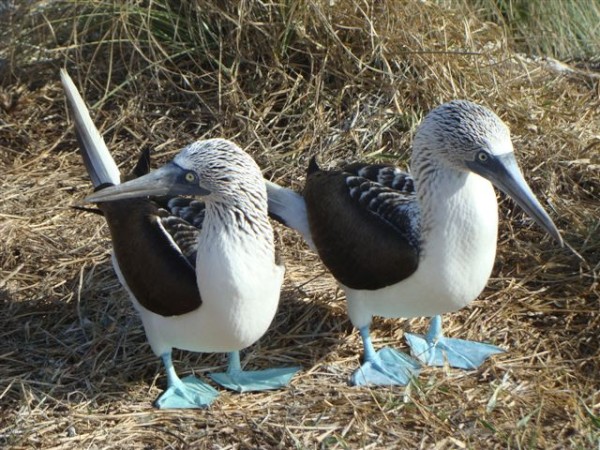 |
Some of the birds, fish, reptiles, and mammals (and others) that we have seen in Mexico
74 Photos
Created 5 May 2014
|
Tregoning

Who: Alison and Randall
Port: Gainesville, FL
